Thermal Bridge Modeling According to Time-Varying Indoor Temperature for Dynamic Building Energy Simulation Using System Identification
Abstract
:1. Introduction
2. Methods
2.1. Building Envelope Analysis and Thermal Bridge Modeling Concept
2.2. Indoor Temperature and Thermal Bridge Modeling
2.2.1. Indoor Temperature: Constant
2.2.2. Indoor Temperature: Variable
- Step 1: Disaggregation stageDetermine the dimensional system.
- Step 2: Dynamic simulation stagePerform the dynamic simulation of the entire wall and the clear wall.
- Step 3: Model construction stageChoose the LTI system order of the TB region and construct the TB transfer function.
- Step 4: System identification stageObtain the parameters of TB transfer function using the system identification process.
2.3. Model Construction and System Identification for Thermal Bridge
2.3.1. Linear Time-Invariant System
2.3.2. Thermal Bridge Transfer Function for the Indoor Temperature
3. Explanatory Example
3.1. Geometry and Materials
3.2. System Identification and Validation Process
4. System Identification Results and Step Response Validation
5. Annual Simulation Validation
6. Discussion
7. Conclusions
- In the same way as in steady-state thermal bridge analysis, the thermal bridge model explains the remaining heat flow after subtracting the heat flow that enters the room through the clear wall that can be analyzed in one dimension from the heat flow that enters the room through the entire building envelope.
- The heat flow that enters the room is divided into the heat flow according to the indoor temperature and the heat flow according to the outdoor temperature, and is obtained by adding these values together.
- The thermal bridge model appears in the form of a transfer function, and is divided into the following two types: a transfer function for indoor temperature and a transfer function for outdoor temperature.
- Each thermal bridge model is estimated through system identification using data. At this time, the data are obtained using a precise dynamic analysis program and the transfer function form is determined using the number of poles and zeros by analyzing the thermal network model and considering the relationship between input (indoor temperature and outdoor temperature) and output (heat flow that enters the room) as a linear, time-invariant system.
- The first step: the validation of the model itself.
- -
- Validation of whether the thermal bridge model can explain the data used for system identification.
- The second step: the validation of the annual simulation.
- -
- Validation of whether the thermal bridge model can explain the random annual data.
Author Contributions
Funding
Data Availability Statement
Conflicts of Interest
Appendix A
Thermal Network Model and Transfer Function
- [1]
- 2R1C model
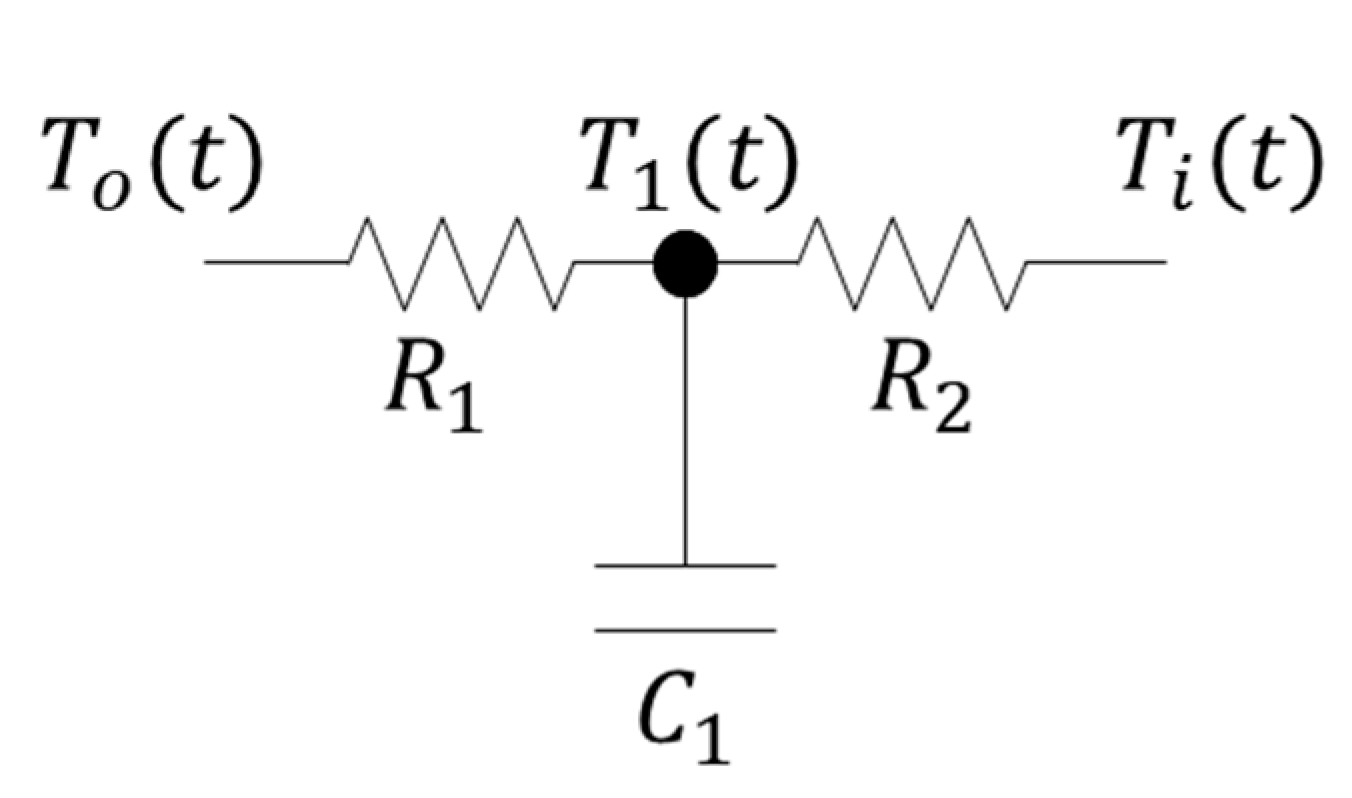
References
- Kamel, E.; Memari, A.M. Residential Building Envelope Energy Retrofit Methods, Simulation Tools, and Example Projects: A Review of the Literature. Buildings 2022, 12, 954. [Google Scholar] [CrossRef]
- Otaegi, J.; Hernández, R.J.; Oregi, X.; Martín-Garín, A.; Rodríguez-Vidal, I. Comparative Analysis of the Effect of the Evolution of Energy Saving Regulations on the Indoor Summer Comfort of Five Homes on the Coast of the Basque Country. Buildings 2022, 12, 1047. [Google Scholar] [CrossRef]
- Emanuele, N.; Antomio, M.; Yi, Z.; Furio, B. Defining The Energy Saving Potential of Architectural Design. Energy Procedia 2015, 83, 140–146. [Google Scholar]
- Ionescu, C.; Baracu, T.; Vlad, G.E.; Necula, H.; Badea, A. The historical evolution of the energy efficient buildings. Renew. Sustain. Energy Rev. 2015, 49, 243–253. [Google Scholar] [CrossRef]
- Li, C.Z.; Zhang, L.; Liang, X.; Xiao, B.; Tam, V.W.; Lai, X.; Chen, Z. Advances in the research of building energy saving. Energy Build. 2022, 254, 111556. [Google Scholar] [CrossRef]
- Charde, M.; Gupta, R. Effect of energy efficient building elements on summer cooling of buildings. Energy Build. 2013, 67, 616–623. [Google Scholar] [CrossRef]
- Aslani, A.; Bakhtiar, A.; Akbarzadeh, M.H. Energy-efficiency technologies in the building envelope: Life cycle and adaptation assessment. J. Build. Eng. 2019, 21, 55–63. [Google Scholar] [CrossRef]
- Crawley, D.B.; Hand, J.W.; Kummert, M.; Griffith, B.T. Contrasting the capabilities of building energy performance simulation programs. Build. Environ. 2008, 43, 661–673. [Google Scholar] [CrossRef] [Green Version]
- Harish, V.; Kumar, A. A review on modeling and simulation of building energy systems. Renew. Sustain. Energy Rev. 2016, 56, 1272–1292. [Google Scholar] [CrossRef]
- Foucquier, A.; Robert, S.; Suard, F.; Stéphan, L.; Jay, A. State of the art in building modelling and energy performances prediction: A review. Renew. Sustain. Energy Rev. 2013, 23, 272–288. [Google Scholar] [CrossRef] [Green Version]
- Agdas, D.; Srinivasan, R.S. Building energy simulation and parallel computing: Opportunities and challenges. In Proceedings of the Winter Simulation Conference, Savannah, GA, USA, 7–10 December 2014; pp. 3167–3175. [Google Scholar]
- Quinten, J.; Feldheim, V. Dynamic modelling of multidimensional thermal bridges in building envelopes: Review of existing methods, application and new mixed method. Energy Build. 2016, 110, 284–293. [Google Scholar] [CrossRef]
- Ge, H.; Baba, F. Effect of dynamic modeling of thermal bridges on the energy performance of residential buildings with high thermal mass for cold climates. Sustain. Cities Soc. 2017, 34, 250–263. [Google Scholar] [CrossRef]
- Martin, K.; Erkoreka, A.; Flores, I.; Odriozola, M.; Sala, J.M. Problems in the calculation of thermal bridges in dynamic conditions. Energy Build. 2011, 43, 529–535. [Google Scholar] [CrossRef]
- Martin, K.; Campos-Celador, A.; Escudero, C.; Gómez, I.; Sala, J.M. Analysis of a thermal bridge in a guarded hot box testing facility. Energy Build. 2012, 50, 139–149. [Google Scholar] [CrossRef]
- Garay, R.; Uriarte, A.; Apraiz, I. Performance assessment of thermal bridge elements into a full scale experimental study of a building façade. Energy Build. 2014, 85, 579–591. [Google Scholar] [CrossRef] [Green Version]
- Berggren, B.; Wall, M. State of knowledge of thermal bridges—A follow up in Sweden and a review of recent research. Buildings 2018, 8, 154. [Google Scholar] [CrossRef] [Green Version]
- Zhang, X.; Jung, G.-J.; Rhee, K.-N. Performance Evaluation of Thermal Bridge Reduction Method for Balcony in Apartment Buildings. Buildings 2022, 12, 63. [Google Scholar] [CrossRef]
- Kim, M.Y.; Kim, H.G.; Kim, J.S.; Hong, G. Investigation of Thermal and Energy Performance of the Thermal Bridge Breaker for Reinforced Concrete Residential Buildings. Energies 2022, 15, 2854. [Google Scholar] [CrossRef]
- Kim, Y.H.; Kim, H.J.; Lee, H.Y. Investigation and analysis of patents for the thermal bridge breaker in green buildings. J. Korean Digit. Archit. Inter. Assoc. 2013, 13, 35–43. [Google Scholar]
- Aghasizadeh, S.; Kari, B.M.; Fayaz, R. Thermal performance of balcony thermal bridge solutions in reinforced concrete and steel frame structures. J. Build. Eng. 2022, 48, 103984. [Google Scholar] [CrossRef]
- DOE. EnergyPlus Version 22.1.0 Documentation: EnergyPlus Engineering Reference; US Department of Energy: Washington, DC, USA, 2016.
- Fiksel, A.; Thornton, J.; Klein, S.; Beckman, W. Developments to the TRNSYS simulation program. J. Sol. Energy Eng. 1995, 117, 123–127. [Google Scholar] [CrossRef]
- Kossecka, E.; Kosny, J. Equivalent wall as a dynamic model of a complex thermal structure. J. Therm. Insul. Build. Envel. 1997, 20, 249–268. [Google Scholar] [CrossRef]
- Nagata, A. A simple method to incorporate thermal bridge effects into dynamic heat load calculation programs. In Proceedings of the International IBPSA Conference, Montreal, QC, Canada, 15–18 August 2005; pp. 817–822. [Google Scholar]
- Xiaona, X.; Yi, J. Equivalent slabs approach to simulate the thermal performance of thermal bridges in building constructions. IbpsaProc. Build Simul. 2007, 10, 287–293. [Google Scholar]
- Martin, K.; Escudero, C.; Erkoreka, A.; Flores, I.; Sala, J.M. Equivalent wall method for dynamic characterisation of thermal bridges. Energy Build. 2012, 55, 704–714. [Google Scholar] [CrossRef]
- Kim, H.; Yeo, M. Thermal Bridge Modeling and a Dynamic Analysis Method Using the Analogy of a Steady-State Thermal Bridge Analysis and System Identification Process for Building Energy Simulation: Methodology and Validation. Energies 2020, 13, 4422. [Google Scholar] [CrossRef]
- Tangirala, A.K. Principles of System Identification: Theory and Practice; CRC Press: Boca Raton, FL, USA, 2018; p. 123. [Google Scholar]
- Bergman, T.L.; Incropera, F.P.; DeWitt, D.P.; Lavine, A.S. Fundamentals of Heat and Mass Transfer; John Wiley & Sons: Hobokene, NJ, USA, 2011. [Google Scholar]
- Ogata, K. System Dynamics; Pearson/Prentice Hall Englewood Cliffs: Upper Saddle River, NJ, USA, 2004; Volume 13. [Google Scholar]
- Xu, X.; Wang, S. A simplified dynamic model for existing buildings using CTF and thermal network models. Int. J. Therm. Sci. 2008, 47, 1249–1262. [Google Scholar] [CrossRef]
- Martinez, R.G.; Riverola, A.; Chemisana, D. Disaggregation process for dynamic multidimensional heat flux in building simulation. Energy Build. 2017, 148, 298–310. [Google Scholar] [CrossRef]
- PHYSIBEL. TRISCO v11.0w Manual; PHYSIBEL: Gent, Belgium, 2005. [Google Scholar]
- PHYSIBEL. VOLTRA v6.0w Manual; PHYSIBEL: Gent, Belgium, 2006. [Google Scholar]
- Matlab. MATLAB R2021b; Mathworks: Natick, MA, USA, 2021. [Google Scholar]
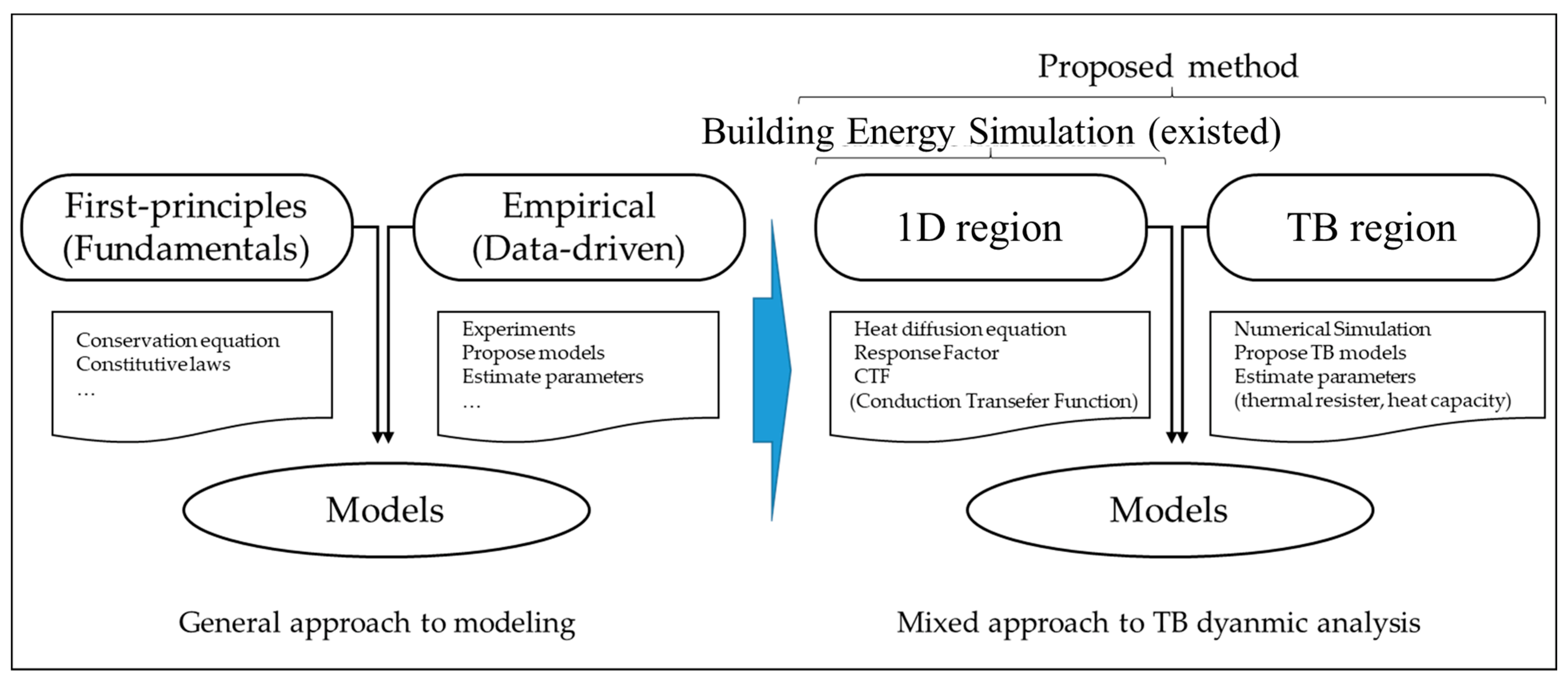
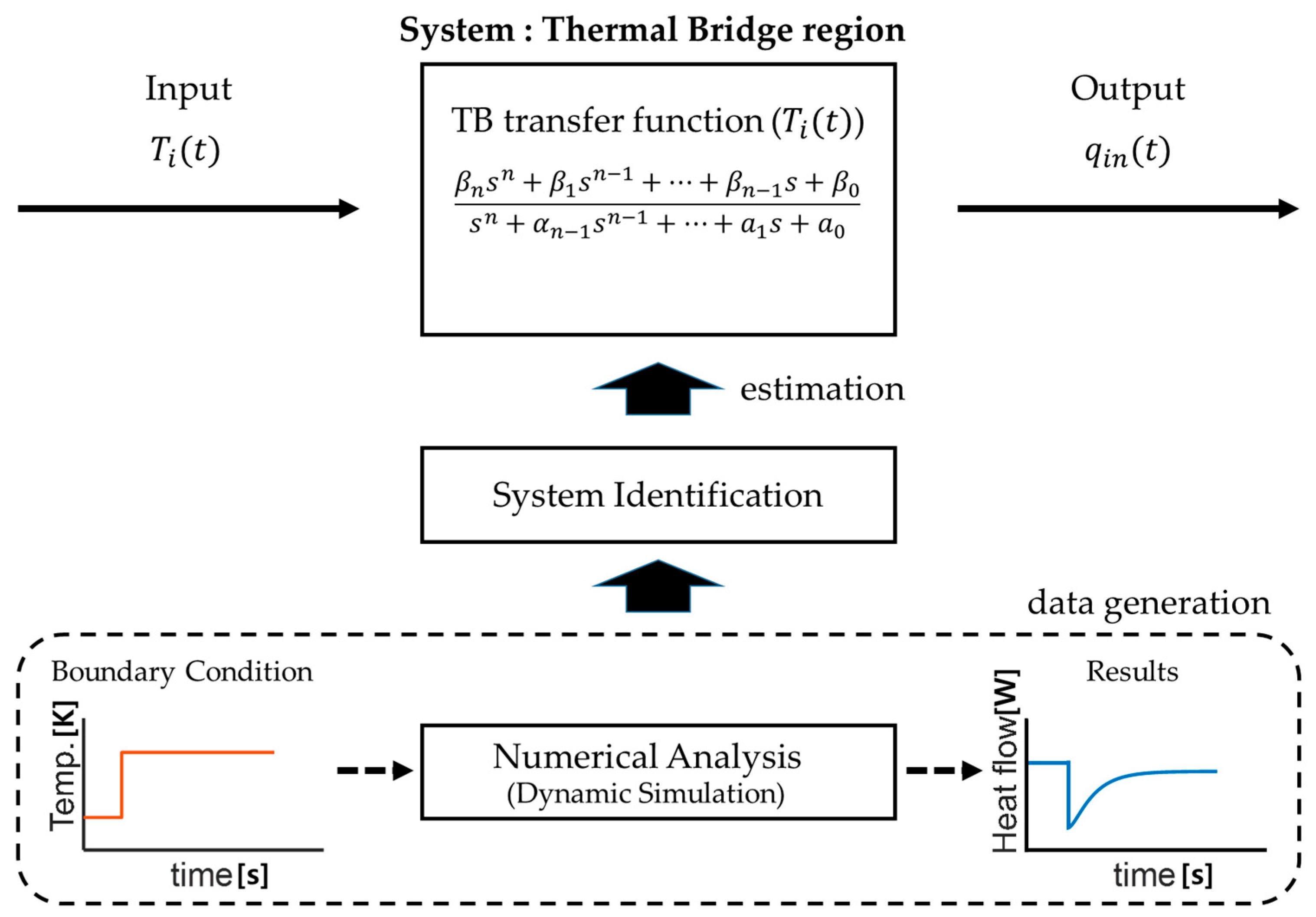
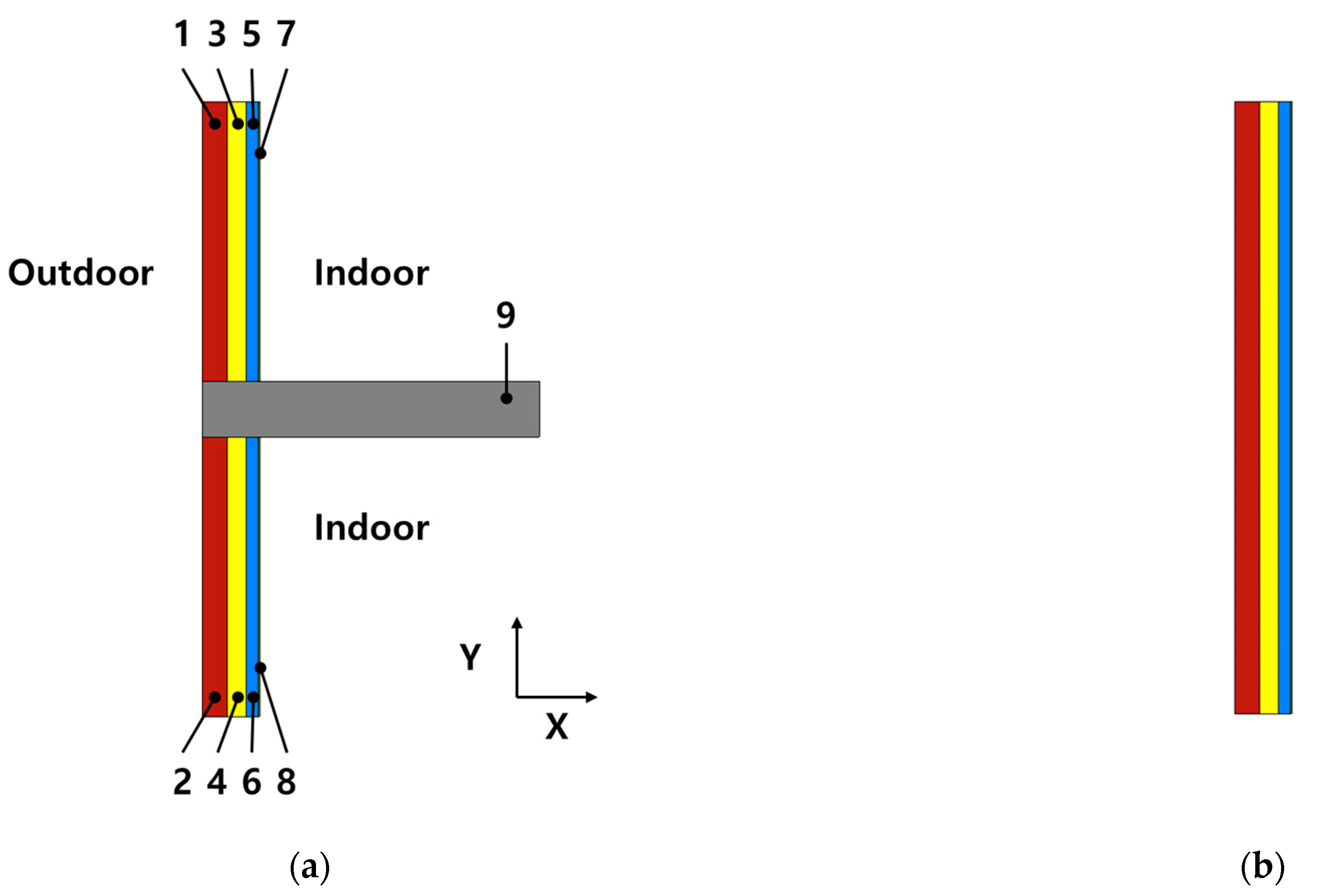
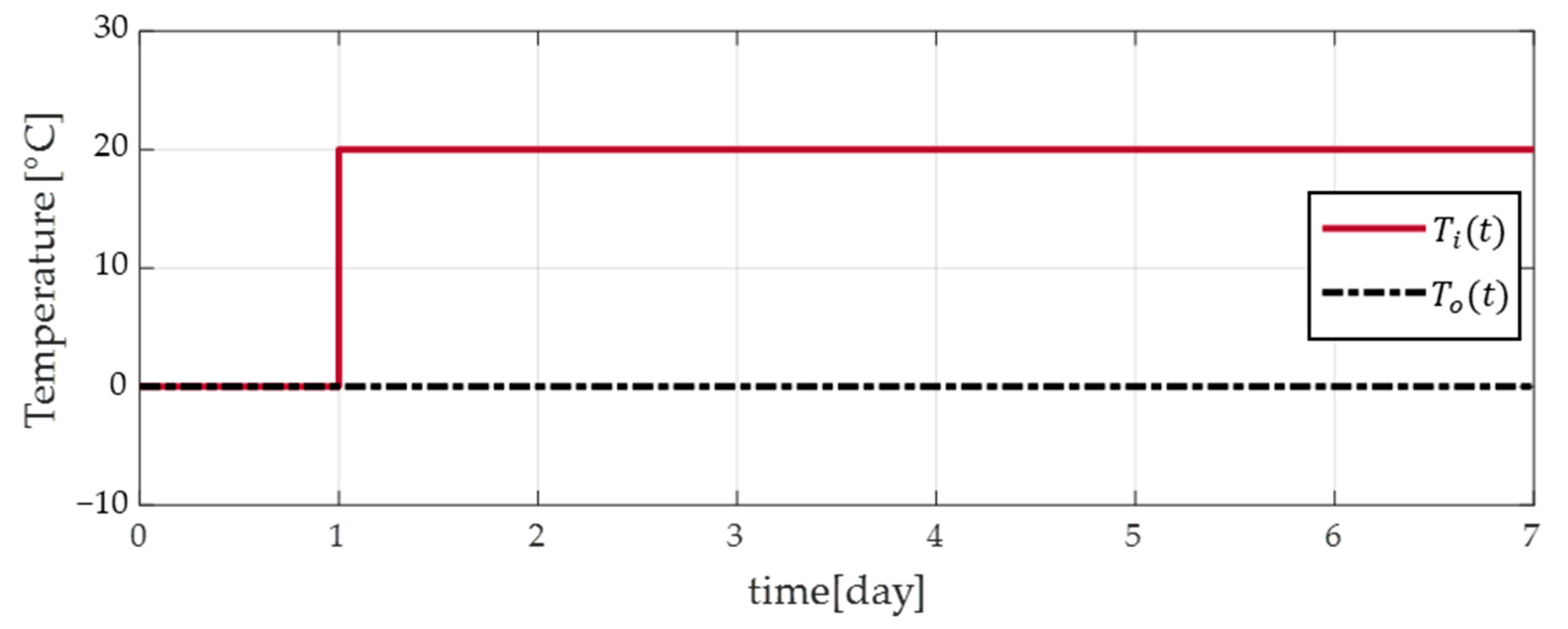

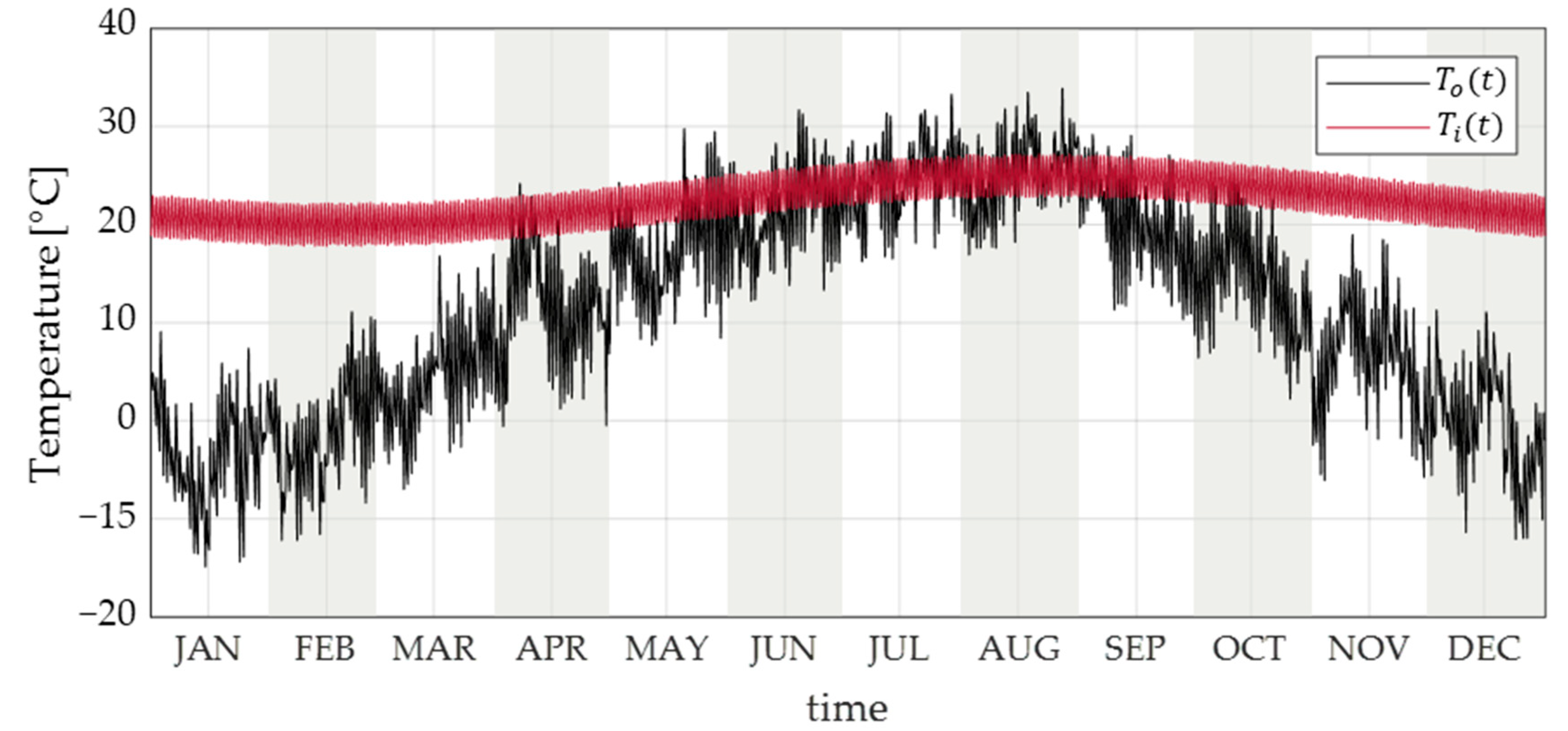
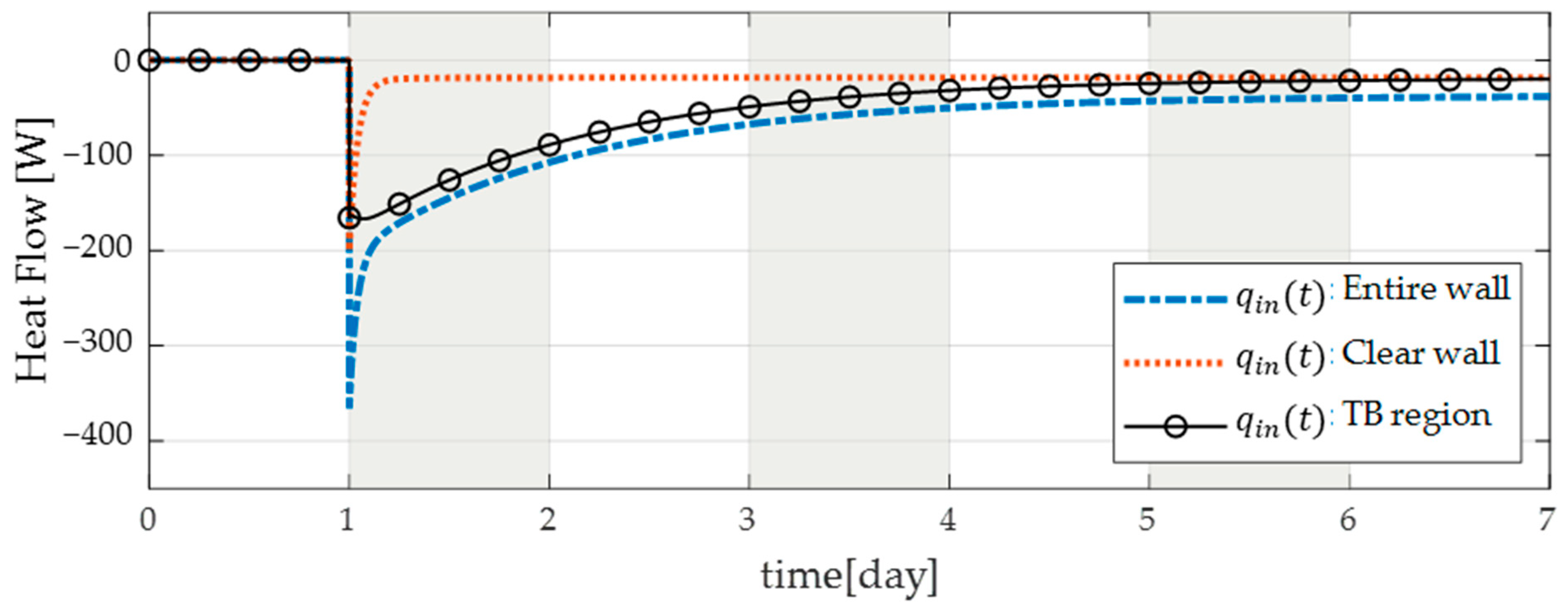
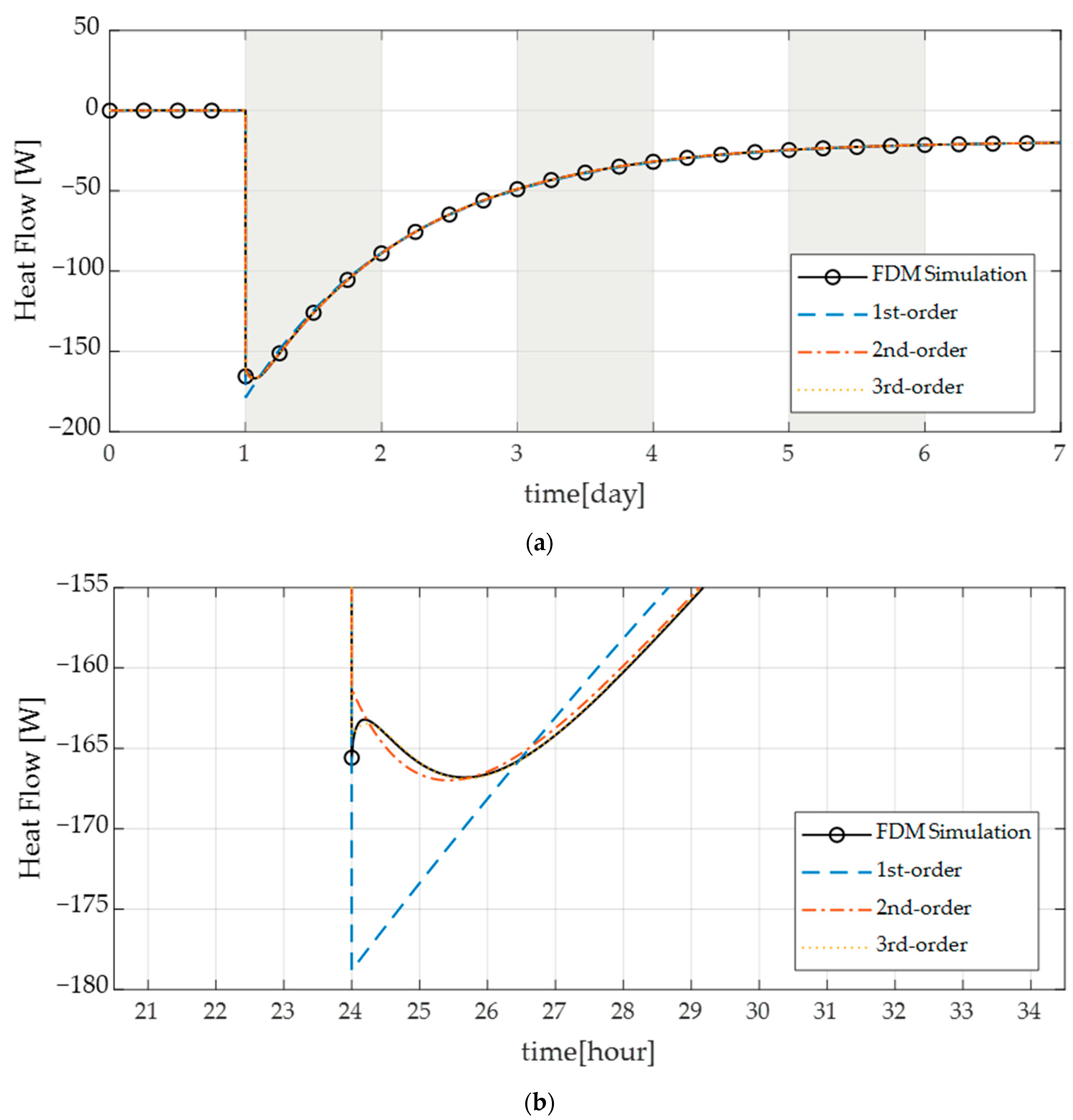
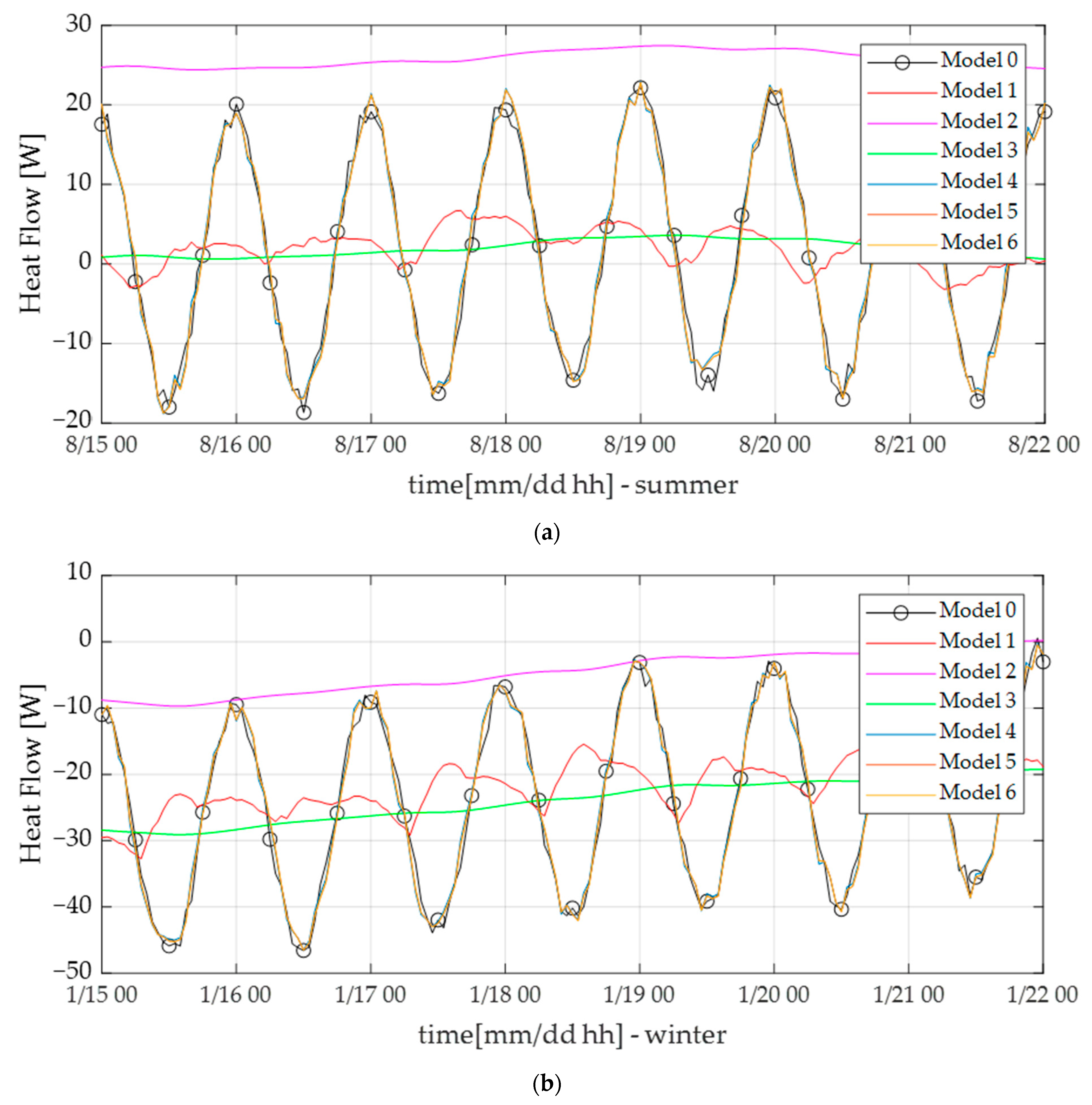
| # 1 | Material | Lx 2 (mm) | Ly 3 (mm) | 4 (W/mK) | 5 (kg/m3) | 6 (J/kgK) |
|---|---|---|---|---|---|---|
| 1 | Brick | 135 | 1500 | 0.700 | 1600.0 | 850.0 |
| 2 | 135 | 1500 | 0.700 | 1600.0 | 850.0 | |
| 3 | Extruded polystyrene | 100 | 1500 | 0.035 | 25.0 | 1470.0 |
| 4 | 100 | 1500 | 0.035 | 25.0 | 1470.0 | |
| 5 | Air gap | 65 | 1500 | 0.560 | 1.185 | 1004.4 |
| 6 | 65 | 1500 | 0.560 | 1.185 | 1004.4 | |
| 7 | Plasterboard | 10 | 1500 | 0.500 | 1300.0 | 840.0 |
| 8 | 10 | 1500 | 0.500 | 1300.0 | 840.0 | |
| 9 | Concrete | 1810 | 300 | 2.600 | 2300.0 | 930.0 |
| Dimensional System | Thermal Transmittance | Heat Flow | ||||
|---|---|---|---|---|---|---|
| Entire Wall (W/m2K) | Clear Wall (W/m2K) | TB Region (W/mK) | Entire Wall (W) | Clear Wall (W) | TB Region (W) | |
| External | 0.6945 | 0.2980 | 1.3086 | 45.8376 | 19.6657 | 26.1719 |
| Time Step | Duration | Initial Condition | Boundary Condition |
|---|---|---|---|
(20 days) | All structures and | (1 day) (1 day) |
| Model # 1 | Description |
|---|---|
| Model 0 | FDM model as exact solution |
| Model 1 | Steady-state model (T) |
| Model 2 | Only 3rd order TB transfer function |
| Model 3 | Only 3rd order TF with arithmetic correction of |
| Model 4 | 3rd order TB transfer function + 1st order TB transfer function |
| Model 5 | 3rd order TB transfer function + 2nd order TB transfer function |
| Model 6 | 3rd order TB transfer function + 3rd order TB transfer function |
| System Order | First-Order | Second-Order | Third-Order | |
|---|---|---|---|---|
| Transfer Function | ||||
| # 1 of poles | 1 | 2 | 3 | |
| # 1 of zeros | 1 | 2 | 3 | |
| −9.1193 × 10−6 | −1.8796 × 10−9 | −1.7402 × 10−12 | ||
| −8.9426 | −1.8304 × 10−3 | −1.6960 × 10−6 | ||
| - | −8.0620 | −8.0498 × 10−3 | ||
| - | - | −8.2158 | ||
| 9.6066 × 10−6 | 1.9727 × 10−9 | 1.8266 × 10−12 | ||
| - | 2.1032 × 10−4 | 1.9551 × 10−7 | ||
| - | - | 9.9425 × 10−4 | ||
| NRMSE 2 | 0.0254 | 0.0024 | 0.0008 | |
| FPE 3 | 0.4573 | 0.0041 | 3.5690 × 10−4 | |
| MSE 4 | 0.4572 | 0.0041 | 3.5665 × 10−4 | |
| Model 1 | Model 2 | Model 3 | Model 4 | Model 5 | Model 6 | |
|---|---|---|---|---|---|---|
| RMSE | 13.3204 | 24.9975 | 12.8481 | 1.8147 | 1.6967 | 1.6951 |
| NRMSE | 0.8772 | 1.6424 | 0.8461 | 0.1195 | 0.1117 | 0.1116 |
| R2 | 0.2396 | 0.2996 | 0.2845 | 0.9857 | 0.9875 | 0.9875 |
Publisher’s Note: MDPI stays neutral with regard to jurisdictional claims in published maps and institutional affiliations. |
© 2022 by the authors. Licensee MDPI, Basel, Switzerland. This article is an open access article distributed under the terms and conditions of the Creative Commons Attribution (CC BY) license (https://creativecommons.org/licenses/by/4.0/).
Share and Cite
Kim, H.; Kim, J.; Yeo, M. Thermal Bridge Modeling According to Time-Varying Indoor Temperature for Dynamic Building Energy Simulation Using System Identification. Buildings 2022, 12, 2178. https://doi.org/10.3390/buildings12122178
Kim H, Kim J, Yeo M. Thermal Bridge Modeling According to Time-Varying Indoor Temperature for Dynamic Building Energy Simulation Using System Identification. Buildings. 2022; 12(12):2178. https://doi.org/10.3390/buildings12122178
Chicago/Turabian StyleKim, Heegang, Jihye Kim, and Myoungsouk Yeo. 2022. "Thermal Bridge Modeling According to Time-Varying Indoor Temperature for Dynamic Building Energy Simulation Using System Identification" Buildings 12, no. 12: 2178. https://doi.org/10.3390/buildings12122178







